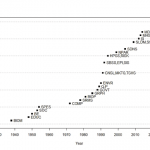ASA Sections: Past, Present, and Future
The ASA will celebrate its 175th anniversary in 2014. In preparation, column “175”—written by members of the ASA’s 175th Anniversary Steering Committee and other ASA members—will chronicle the theme chosen for the celebration, status of preparations, activities to take place, and, best yet, how you can get involved in propelling the ASA toward its bicentennial.
Contributing Editors
Nick Beyler is a statistician at Mathematica Policy Research and secretary for the ASA Council of Sections Governing Board. He graduated with a PhD in statistics from Iowa State University in 2010.
John Czajka is a senior fellow at Mathematica Policy Research, his employer since 1978. He is chair-elect of the Council of Sections, immediate past chair of the Survey Research Methods Section, a past chair of the Government Statistics Section, and a past president of the Washington Statistical Society.
Katherine Halvorsen has taught statistics at Smith College since 1989 and directs the program in applied statistics there. She chairs the Council of Sections and has served as the ASA’s Meeting Within a Meeting program chair, chair of the Advisory Committee on Continuing Education, and secretary-treasurer of the executive committee for the Section on Statistical Education.
Eileen King is associate professor in the division of biostatistics and epidemiology at Cincinnati Children’s Hospital Medical Center. Prior to joining CCHMC, she was head of the department of biometrics and statistical sciences at The Procter & Gamble Company. She is past-chair of the Council of Sections Governing Board.
John McKenzie is a professor emeritus of statistics at Babson College. He is a Fellow and Founders Award winner of the American Statistical Association. He earned an AB from Amherst College and two master’s degrees and a PhD in statistics from the University of Michigan.
Part of “celebrating our past, energizing our future” is recognizing the importance of ASA sections in the life and growth of our association. Sections provide vital connections for our members, and they reflect the role of the ASA as “the Big Tent for Statistics.” Two months out from the start of our 175th anniversary year, we look at the past, present, and future of sections and encourage everyone to join in.
The development of inferential statistical techniques and their applications led in the 1920s and 1930s to the formation of several ASA subject-matter committees, the precursor of sections. Under the leadership of George Snedecor and others, one of those committees, Biometrics, became the ASA’s first section in 1938, nearly 100 years after the founding of the ASA. The Section on Statistical Training was founded nine years later and became the Section on Statistics Education in 1974 at the instigation of Bob Hogg. In the early 1950s, three more sections—Business and Economic Statistics, Social Statistics, and Physical and Engineering Sciences—were added. The next section, Statistical Computing, did not appear until 1972 and was followed, six years later, by Survey Research Methods. Two more sections—Biopharmaceutical and Statistical Graphics—were founded over the next seven years. Section formation accelerated after that, with 11 sections being added between 1988 and 1994. Seven more have been added since, including five in the past five years, bringing us to a total of 27 sections. More than half of these have been established since the 150th anniversary of the ASA in 1989. ASA members continue to create new ways to connect and collaborate with statistical colleagues with similar interests.
In his 2012 presidential address, Bob Rodriguez characterized the ASA as the “Big Tent for Statistics.” He said “the ASA must attract all kinds of statisticians; serve their professional development needs; and promote their societal contributions to the public, the media, and policymakers.” In fact, each of the past four ASA presidents has noted the far-reaching influence of statistics and the increasing demand for statisticians.
The growth in demand for statistical expertise will bring increased demand for even more ASA sections in new areas of statistics not supported by the current sections. We anticipate the number of sections will increase rapidly in the next decade. How we deal with this growth will require a new way of thinking about the purpose, structure, and function of ASA sections.
Now is the time for all section members to consider the following: How should the structure of ASA sections evolve to ensure they meet the needs of section members? Should we have a few consolidated groups of sections, such as education, sciences, and social sciences? Should we return to a structure that includes specialized subsections within existing sections? Where do interest groups fit into this structure? How should we use technology to facilitate more frequent communication within and between sections?
To remain a vital organization, innovation will be required as we strive to attract new ASA members who want to develop highly collaborative relationships with others who share their passion.
If you are not yet a member of a section, you are missing out. Each section provides a wide range of services to their members through webinars, workshops, short courses, conference seminars, mixers, awards, research funding opportunities, and resources for job searching, to name just a few. Did you know statistical programmers and analysts have an active blog that gets posts on a regular basis and that the consulting section deals with topics ranging from how to address particular data analysis problems to the value of PSTAT accreditation for consultants? This, and other noteworthy information, can be found at each section’s website.
Want to join? It is easy to do from the ASA home page. Want to get involved? Contact Rick Peterson at rick@amstat.org.


















